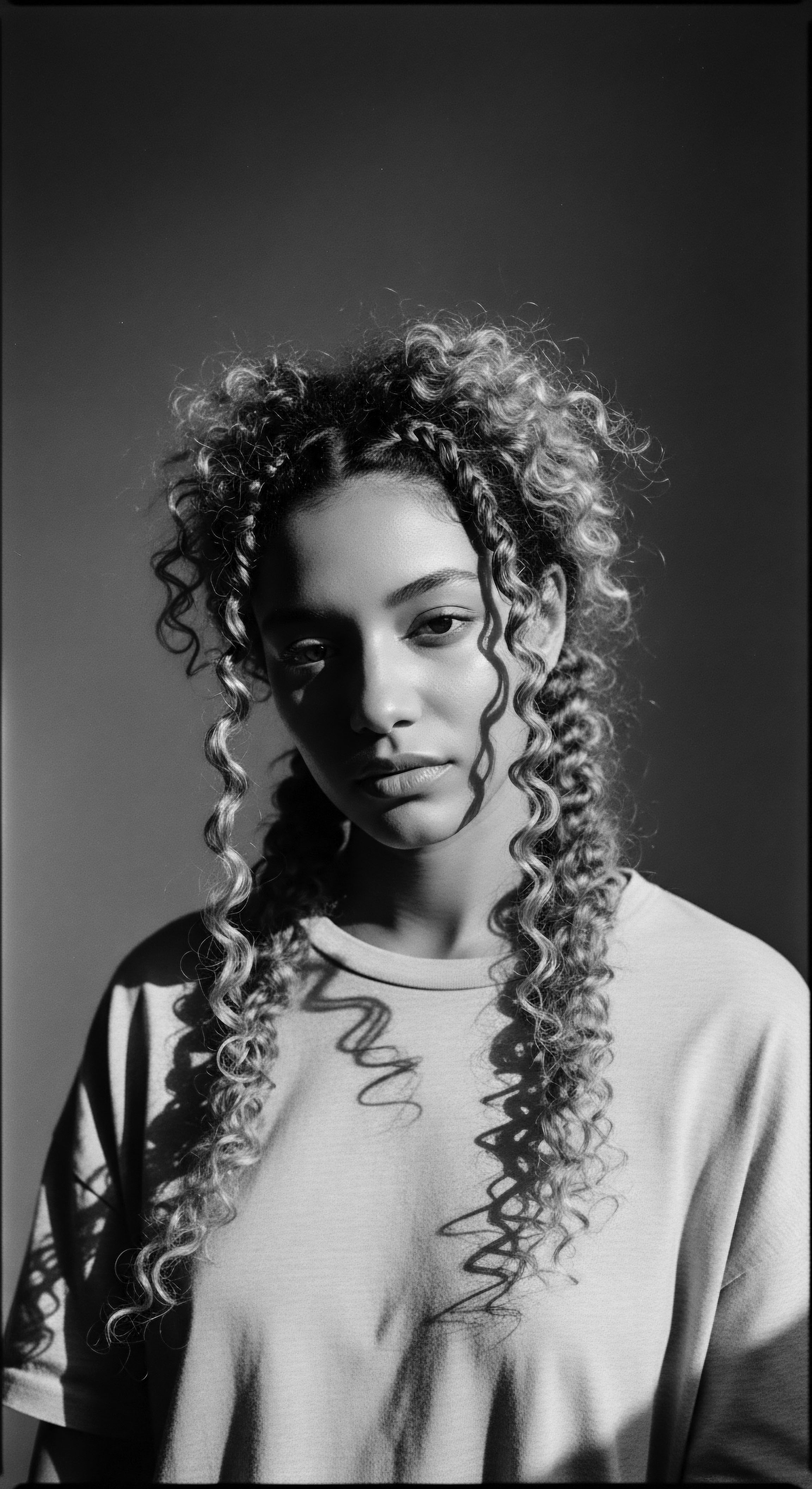
Roots
The very notion of cleansing textured coils, whether in the vibrant present or the hushed echoes of ages past, reaches beyond simple hygiene. It touches upon the deep currents of ancestral wisdom, a connection to the earth and its bounty that shaped not just how our forebears cared for their crowns, but how they understood themselves within the cosmos. For many, the hair is a spiritual conduit, a marker of identity, a living archive of generations.
To ask whether ancient cleansers suit modern textured coils compels us to listen closely to these voices from the source, discerning the timeless efficacy of practices born from necessity and intimate knowledge of the botanical world. It is a dialogue between the elemental and the engineered, seeking resonance where the wisdom of the old world meets the demands of the new.

The Architecture of Textured Strands
To truly appreciate the suitability of ancient cleansers, one must first comprehend the inherent characteristics of textured hair itself. Unlike straight or wavy hair, coiled strands possess a unique elliptical or flattened cross-section, which contributes to their distinctive curl pattern. This shape, coupled with fewer cuticle layers, means textured hair often experiences more friction between individual strands, leading to a tendency towards dryness and tangling. The cuticle, the outermost protective layer of the hair shaft, is also more open in coiled hair, allowing moisture to escape more readily.
This intrinsic propensity for dryness is a key consideration when assessing any cleansing agent, ancient or contemporary. Our ancestral kin, living intimately with nature, instinctively understood this need for gentleness and moisture preservation, often seeking out cleansing agents that did not strip the hair of its vital oils.
The intrinsic architecture of textured hair, with its elliptical shape and fewer cuticle layers, often leads to a natural inclination towards dryness.

Cleansing Lore from Ancient Lands
Across various ancestral landscapes, the approach to cleansing was often intrinsically linked to the surrounding environment and the plants it provided. Before the advent of synthetic surfactants, people relied upon the earth’s natural lathering agents. Consider the diverse plant-based cleansers utilized by communities across Africa. For example, in parts of West Africa, a common cleansing agent, particularly renowned for its gentle yet effective properties, was a concoction derived from certain barks and leaves.
This tradition, deeply rooted in the ethnobotany of the region, points to a clear understanding of what textured hair required. Such practices underscore a continuity of care, where indigenous knowledge provided sophisticated solutions long before modern chemistry intervened (Thomas, 2007).

Herbal Infusions and Earth Washes
Many ancient practices involved simple yet potent herbal infusions. Plants containing saponins, natural soap-like compounds, were favored for their ability to cleanse without excessive harshness. The preparation often involved crushing or boiling plant matter, creating a gentle sudsing liquid.
- Aloe Vera ❉ Used across various African and diasporic communities, its mucilaginous gel provided gentle cleansing and intense hydration.
- Soapwort (Saponaria Officinalis) ❉ Though more prevalent in European traditions, its saponin-rich roots were a global discovery for natural cleansing, applicable to various hair types.
- Clay Earths ❉ Clays like rhassoul, bentonite, or kaolin, sourced from specific geological deposits, were mixed with water to form purifying pastes. These earths possessed anionic properties, drawing out impurities and excess oil while imparting minerals.
The wisdom embedded in these methods was not simply about cleaning; it concerned maintaining the hair’s integrity, its inherent moisture, and its natural balance. For our ancestors, hair care was a holistic practice, intertwined with wellness and spiritual alignment.

Did Ancient Practices Validate Modern Science?
The efficacy of these time-honored cleansers finds resonance in contemporary understanding of hair chemistry. Modern science now explains how saponins work as natural surfactants, creating a gentle lather that lifts dirt without stripping the scalp’s natural oils. The mineral content of clays, too, can be understood through the lens of chelating agents, helping to remove hard water deposits and product buildup. This interplay of ancient wisdom and modern scientific validation strengthens the argument for their relevance.
The question then shifts ❉ can these elemental approaches, born from direct communion with nature, truly meet the complex needs and environmental exposures of modern textured coils? The answer begins with a deep recognition of what these traditions sought to achieve ❉ clean hair, yes, but also a healthy, respected, and revered scalp and strand.

Ritual
The act of cleansing, for our ancestors, was seldom a hurried task; it was a ritual, a tender thread connecting the individual to community, to tradition, and to the living world. The suitability of ancient cleansers for modern textured coils, therefore, extends beyond chemical composition; it encompasses the spirit of care, the intention behind the application, and the cultural resonance of the practice. The very tempo of these historical rituals often stands in stark contrast to the fast-paced routines of contemporary life, inviting a deeper consideration of what genuine hair wellness truly requires.

The Practice of Cleansing Through Time
Traditional cleansing routines were often integrated into broader care regimens, preparing the hair for styling, adornment, or community gatherings. The meticulous preparation of plant-based washes or clay mixtures spoke to a patience, a reverence for the process that is often overlooked today. These preparations were not mass-produced; they were often handcrafted within households or communities, their specific formulations passed down through generations.

Alata Samina and Its Ancestral Legacy
One particularly potent example of an ancient cleanser with enduring relevance is African Black Soap, often referred to by its West African name, Alata Samina. Originating in countries like Ghana, Nigeria, and Togo, this soap is traditionally made from the ash of locally harvested plants such as plantain peels, cocoa pods, and shea tree bark, mixed with oils like shea butter or palm kernel oil. Its preparation is a labor of love, a traditional process that varies subtly from one community to the next. The resulting soap is rich in plant-derived glycerin, offering a gentle yet effective cleanse that is remarkably conditioning.
This ancestral cleanser, having been used for centuries across West Africa for skin and hair, illustrates a profound understanding of saponification and its benefits, long before formal chemistry named the process. (Thomas, 2007, p. 45).
African Black Soap, or Alata Samina, stands as a testament to ancestral ingenuity, providing a conditioning cleanse from plant-derived ingredients.
The use of Alata Samina on textured hair, even today, demonstrates its cleansing efficacy without stripping the hair’s natural moisture, a concern particularly important for coils prone to dryness. Its gentle nature, coupled with its historical use across diverse textured hair types, positions it as a powerful contender in the modern hair care landscape.
| Traditional Cleansing Agent Plant Saponins (e.g. Alata Samina, Soapnut) |
| Primary Mechanism of Action Natural surfactants, gentle lather, conditioning |
| Modern Product Category Equivalent Low-poo shampoos, cleansing conditioners |
| Traditional Cleansing Agent Clay Washes (e.g. Rhassoul, Bentonite) |
| Primary Mechanism of Action Absorbent, detoxifying, mineralizing, gentle impurity removal |
| Modern Product Category Equivalent Detoxifying masks, clarifying shampoos |
| Traditional Cleansing Agent Herbal Infusions (e.g. Hibiscus, Amla) |
| Primary Mechanism of Action Mild cleansing, pH balancing, conditioning, strengthening |
| Modern Product Category Equivalent Herbal rinses, pH-balanced shampoos, pre-poo treatments |
| Traditional Cleansing Agent These ancestral methods provided multi-functional care, reflecting a holistic understanding of hair health that resonates with contemporary natural hair movements. |

From Ancient Wisdom to Modern Formulations
The transition from ancient cleansing practices to modern textured coil care involves more than just a switch in ingredients; it often signifies a shift in methodology. Contemporary cleansers often aim for quick results, emphasizing strong lather and immediate detangling. Yet, many ancient methods prioritized slow infusion, patient application, and a deep connection to the ingredients themselves.
Could the foundational principles of ancient cleansing, those emphasizing gentleness, natural conditioning, and mineral replenishment, truly align with the performance expectations of today’s textured hair enthusiasts? The answer rests in recognizing that while the forms may differ, the core need for effective yet non-stripping cleansing for coils remains constant. Many modern formulations now draw inspiration from these very traditions, seeking to replicate the balanced cleansing provided by ancient botanicals without the harshness of some synthetic agents. This thoughtful approach ensures the enduring suitability of heritage practices.

The Interplay of Ancient Cleansers and Styling Heritage
Cleansing, then as now, sets the stage for styling. A clean, balanced scalp and well-prepared strands are foundational for healthy protective styles, intricate braids, or artful twists. Ancient cleansers, by not overly stripping the hair, preserved its natural elasticity and pliability, making subsequent styling easier and less damaging.
This connection highlights a continuum of care ❉ proper cleansing has always been the first step in a larger aesthetic and protective hair tradition. The historical effectiveness of these cleansers in preparing hair for complex styles, such as those seen in ancient African kingdoms, offers compelling evidence of their inherent suitability.

Relay
The conversation around ancient cleansers and modern textured coils moves beyond mere efficacy to encompass a deeper cultural relay—a passing of wisdom from one generation to the next, often through the very strands of hair themselves. This exploration invites us to consider the nuanced interplay of historical context, scientific validation, and the profound role of hair in voicing identity and shaping collective futures within Black and mixed-race communities. The question of suitability becomes less about a simple ‘yes’ or ‘no’ and more about understanding adaptation, reverence, and the evolving spirit of ancestral practices in a contemporary world.

Ancestral Wisdom and the Modern Regimen
The contemporary textured hair regimen, a carefully curated sequence of care, often seeks to optimize moisture retention and minimize manipulation. When considering ancient cleansers within this framework, their inherent properties—gentle lather, natural conditioning agents, and mineral content—align remarkably well with these modern objectives. For example, the humectant properties of certain plant mucilages, used historically as cleansers and conditioners, speak to an intuitive understanding of hydration that scientific literature now verifies. The challenge lies in translating these traditional preparations for ease of use in a fast-paced environment while retaining their core benefits and cultural integrity.

Adapting Ancient Formulations for Today?
The question emerges ❉ how might the active components of historical cleansing agents be effectively integrated into today’s sophisticated formulations for coiled hair? Modern science permits the isolation and stabilization of beneficial compounds from plants traditionally used for cleansing. Consider the saponins from sources like soap nuts or the deep conditioning fatty acids in shea butter, a consistent component in African Black Soap.
Extracting and formulating these elements into modern shampoos or co-washes allows for a controlled application, standardized potency, and extended shelf life, addressing practical concerns of the modern consumer. This thoughtful adaptation honors the legacy of these ingredients while making their benefits accessible.
However, it is crucial to recognize that a mass-produced product, even one inspired by ancestral ingredients, may lose some of the intangible benefits associated with a handmade, ritualistic preparation. The connection to the earth, the communal act of gathering and processing ingredients, and the intentionality imbued in each step contribute to the holistic experience of ancestral hair care.
- Formulation Precision ❉ Modern techniques permit precise concentrations of cleansing agents, ensuring consistent performance.
- Ingredient Sourcing Ethics ❉ A renewed focus on fair trade and sustainable sourcing for ingredients like shea butter mirrors the ancestral respect for natural resources.
- Scalp Microbiome Consideration ❉ Contemporary understanding of the scalp’s delicate microbiome adds a layer of scientific insight, suggesting that harsh cleansers disrupt this balance, making gentle ancient alternatives even more appealing.

The Holistic Influence on Hair Health
Ancestral wellness philosophies viewed the body as an interconnected system, and hair was no exception. Cleansing was not merely about removing dirt; it was about preparing the scalp for growth, nourishing the strands, and maintaining overall well-being. This perspective offers a profound counterpoint to purely aesthetic or product-driven modern approaches.
Take, for instance, the historical use of certain clays or ash-based washes. Beyond their cleaning abilities, these substances often imparted minerals that were believed to strengthen the hair and promote scalp health. Scientific analysis of such materials often reveals beneficial micronutrients.
The enduring suitability of these ancient cleansers, then, often rests in their holistic contribution to the hair’s ecosystem, rather than a singular focus on lather or detangling. It is about fostering a truly healthy environment for the coil from root to tip.
Ancient cleansers, through their gentle properties and mineral content, frequently align with modern goals of maintaining scalp health and hair integrity.

The Unbound Helix and Identity
Textured hair, for Black and mixed-race communities, has always served as a powerful emblem of identity, resilience, and cultural continuity. The choice of cleanser, then, extends beyond personal preference; it can become a statement of connection to heritage, a conscious decision to honor traditional knowledge. Opting for cleansers rooted in ancient practices, or for modern formulations that respectfully incorporate ancestral ingredients, becomes a way of speaking the language of lineage through one’s hair. This act of choosing consciously reinforces the idea that our hair is not merely strands, but an unbound helix, carrying the genetic and cultural memory of our past into our present and future.
It becomes a ritual of affirmation, a daily practice that ties us back to the enduring wisdom of those who came before us. The suitability of ancient cleansers is thus affirmed not only by their inherent properties but by their capacity to echo and amplify the deep cultural resonance of textured hair itself.

Reflection
As we close this inquiry into whether ancient cleansers suit modern textured coils, we find ourselves not at an end, but at a reaffirmation of the timeless wisdom held within our strands. The journey through history, science, and cultural practices reveals a resounding echo ❉ the principles guiding ancestral care remain remarkably pertinent. From the gentle efficacy of saponin-rich plants to the mineral-laden touch of earth washes, these methods, born of intimate communion with nature, speak directly to the unique needs of coiled hair. They remind us that true cleansing extends beyond stripping away impurities; it involves an act of honoring, a deliberate connection to the legacy that shaped our hair’s very architecture.
Our modern coils, navigating complex environments and styling demands, can indeed find profound benefit in these ancient whispers. Whether through direct application of traditional preparations or the conscious selection of contemporary formulations that thoughtfully distill ancestral ingredients, the path forward is one of harmony. It is a path where scientific understanding illuminates the ingenious solutions of the past, and where the rhythmic rituals of our forebears guide us towards holistic well-being. This ongoing dialogue between antiquity and modernity ensures that the ‘Soul of a Strand’ continues its luminous relay, a living archive of resilience, beauty, and inherited wisdom, forever unbound.

References
- Thomas, Gwendolyn. (2007). African American Hair Care ❉ A Cultural and Historical Guide. Greenwood Press.
- Davis-Sivasothy, Audrey. (2011). The Science of Black Hair ❉ A Comprehensive Guide to Textured Hair Care. SAJA Publishing Company.
- D. N. K. Dzifa and M. A. Agyekum. (2018). “Ethnobotanical Survey of Medicinal Plants Used for Hair and Scalp Care in Selected Communities of Ghana.” Journal of Medicinal Plants Studies, 6(3), 1-5.
- K. Adomako and G. Obeng-Darko. (2016). “Traditional Hair Care Practices among the Akan of Ghana.” Journal of Traditional and Complementary Medicine, 6(1), 81-86.
- W. H. Lewis. (1998). Medicinal Plants of the World ❉ Chemical Constituents, Traditional and Modern Medicinal Uses. Timber Press.
